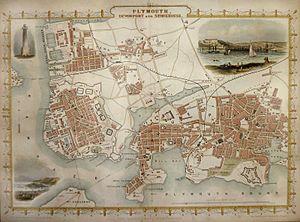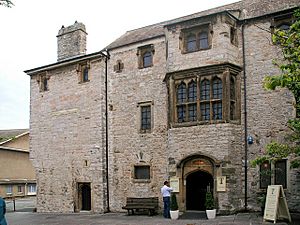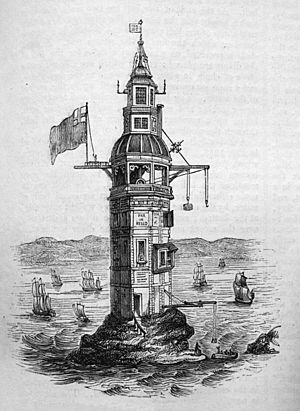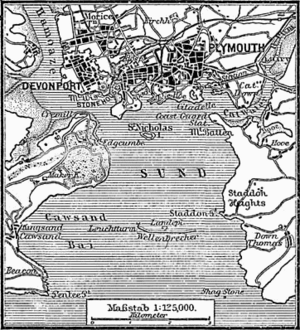History of Plymouth facts for kids
The History of Plymouth in Devon, England, goes way back to the Bronze Age. That's when the first people settled at Mount Batten, a small piece of land sticking out into Plymouth Sound. This spot was perfect because it faced the English Channel.
Plymouth was a busy port for fishing and trading tin with other countries. This continued through the Iron Age and into the Early Middle Ages. Later, a more successful Saxon village called Sutton grew up nearby. This village eventually became what we know as Plymouth today.
Because of its great natural harbour and easy access to the Atlantic Ocean, Plymouth became very important. It played a big role when Britain started exploring and settling new lands, especially in the New World. In 1620, the Pilgrim Fathers even sailed from Plymouth to start the second English colony in America.
During the English Civil War (1642-1646), Plymouth was under attack by the Royalists. But it held strong! After the war, a big Dockyard was built in the nearby town of Devonport. Plymouth grew a lot during the Industrial Revolution, becoming a major port for trade and passengers from places like the US. Devonport, meanwhile, became a huge naval base, building powerful battleships for the Royal Navy.
Sadly, this importance also made Plymouth a target during World War II. The city was heavily bombed in what's known as the Plymouth Blitz. After the war, the city centre was completely rebuilt with a new, modern design.
Contents
What's in a Name?
For a long time, the settlement was called Sutton. This simply meant "South town." It was located near Sutton Harbour, which is the oldest part of the city today.
The name "Plymouth" has two parts: "Plym" and "mouth." "Plym" comes from the River Plym. The town used this river for trade with an older settlement called Plympton. The name Plympton itself might come from an old word for "plum tree." Some people think "Plym" could also come from a Celtic word meaning "fort at the head of a creek," or even a Latin word for "white lead" (meaning tin).
By the early 1200s, the river was known as the Plym. Soon after, the town started being called Plymouth.
Plymouth even gave its name to Plymouth, Massachusetts in America. This happened after the Pilgrim Fathers left from here on the Mayflower in 1620. Many other places in North America are also named Plymouth.
Early Days of Plymouth
The very first signs of people living in the Plymouth area come from caves around Plymouth Sound. These "bone caves" have remains from the Upper Paleolithic period, including some of the earliest evidence of modern humans in England. Imagine, a reindeer bone found here is over 15,000 years old! These caves are super important for understanding early human history in Europe.
People once thought that tin from Dartmoor was traded here with the Phoenicians. However, this idea is now mostly dismissed. But we do have proof of copper trading at Mount Batten from the late Bronze Age to the middle Iron Age. Mount Batten was one of the main trading ports in Prehistoric Britain. Tin trading continued there even into the Roman Britain period, but it became less important over time.
Later, the Brythonic kingdom of Dumnonia (where Plymouth is) kept some independence from Rome and later the Anglo-Saxon kingdom of Wessex. This was likely because of its important tin mining.
Around the time of the Domesday Book (1086), the King owned the area of Sutton. But later, parts of it were given to a priory in Plympton. Plympton was a bigger, older town at the top of the tidal river Plym. The part of Sutton owned by the priory got permission to hold a market in 1254. Then, in 1439, the whole town of Sutton became independent, making it the first town in England to be officially recognized by Act of Parliament.
As the upper parts of the Plym river filled with mud, ships started using the Cattewater and the harbour at the mouth of the Plym instead of going all the way to Plympton. That's how the name of the town slowly changed from Sutton to Plymouth. You can still find the name Sutton in its old harbour and a part of the city today.
Plymouth was often attacked by enemies from across the English Channel. During the Hundred Years' War (1337-1453), French attackers tried to burn the town in 1340 but failed. In 1403, Breton raiders briefly took over and burned parts of the town.
In the late 1400s, Plymouth Castle was built to protect Sutton Pool, where the fleet was kept. This castle had four round towers, which you can still see on the city's coat of arms. In 1512, more defenses were built, including walls at the entrance to Sutton Pool. A chain could be stretched across this entrance in times of danger. Defenses were also built on St Nicholas Island and six artillery blockhouses were added. One of these was later strengthened with a fort in 1596, which became the site of the Citadel in the 1660s.
A Time of Great Explorers
The 1500s were a big time for Plymouth. It was the home port for many successful sea traders. One was William Hawkins, who made the first English trips to West Africa in the 1530s. His son, Sir John Hawkins, led England's first involvement in the slave trade.
But the most famous person from Plymouth is probably Sir Francis Drake. He was a navigator, a privateer (a legal pirate!), and a vice admiral in the Royal Navy. Even though he was born in Tavistock, he became mayor of Plymouth in 1581. He's famous for bringing fresh water from Dartmoor to the town using an aqueduct called Drake's Leat. He also helped build up the Tudor defenses around Sutton Harbour. You can still see old, wealthy Elizabethan merchant houses in the city's Barbican area. Many famous people, like Catherine of Aragon and Pocahontas, arrived or left from here.
Plymouth Hoe, a wide grassy area on cliffs overlooking Plymouth Sound, is famous for a national story. It's said that in 1588, when the Spanish Armada was approaching, Sir Francis Drake insisted on finishing his game of bowls. He wanted to wait for the wind and tide to change in his favour, which helped him defeat the Armada.
In 1606, the Plymouth Company was given a special permission by King James I of England. Their goal was to set up settlements on the coast of North America.
A few years later, in 1620, Plymouth was the starting point for the Mayflower. On board were the Pilgrim Fathers, who sailed to the New World. They founded the second permanent English colony in America. When they first saw land, they named their landing spot Plymouth Rock. This was to thank Plymouth for the kindness they received while staying there. Their settlement, Plymouth, Massachusetts, still carries the name of its European origin. Today, the flags of the US and UK fly at the Mayflower Steps to remember this important event.
War, Rebuilding, and New Docks
During the English Civil War, Plymouth supported the Parliamentarians. This meant it was cut off from the rest of Devon and Cornwall, which were controlled by the Royalists. The town was under attack almost constantly from 1642 to 1646. Plymouth survived mainly because the navy stayed loyal to Parliament. This allowed supply ships to arrive regularly and sailors to help defend the town when needed.
Many defenses were built, including earthworks and isolated forts. There were several fights, like the one on Lipson Ridge in 1643, which is remembered by a monument in Freedom Fields Park. After the war, in 1665, construction began on the Royal Citadel. It had cannons facing both the sea and the town. Some say this was a reminder to the people not to go against the King!
In 1691, William of Orange ordered new dockyards to be built at the mouth of the River Tamar. These were to help the Royal Navy in the western seas. A new town, separate from Plymouth, grew up around these docks. It was first called "Dock" or "Plymouth Dock." By 1733, it had 3,000 people. From then on, Plymouth became more and more focused on the Navy. The busy trading port it once was became less important.
The first Eddystone Lighthouse was built in 1696 by Henry Winstanley. It helped protect the growing number of ships sailing past the dangerous reefs near Rame Head.
A Time of Growth and Change
The 1700s saw Plymouth continue to grow. The first theatre was built in 1762, and the first bank in 1772. The nearby towns of Stonehouse and Devonport also grew. Stonehouse got the Royal Marine Barracks in 1782 and the Royal Naval Hospital in 1762. Devonport added more docks in 1727, 1762, and 1793. The first ferry to Torpoint started in 1791.
The towns traded minerals like copper, lime, tin, and arsenic from the countryside. Around 1745, a local chemist named William Cookworthy figured out the secret to Chinese porcelain. He developed the first English porcelain, called Plymouth China. This started the China Clay mining industry in the area.
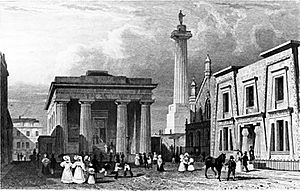
Plymouth, Devonport, and Stonehouse (known as the Three Towns) became quite wealthy in the late 1700s and early 1800s. Many grand public buildings were designed by architect John Foulston. He also planned Union Street, Plymouth, a big road meant to connect the Three Towns.
After his defeat at the Battle of Waterloo in 1815, Napoleon Bonaparte was brought to Plymouth on HMS Bellerophon. The ship stayed in Plymouth Sound for two weeks before Napoleon was sent away to St Helena.
With new threats of invasion from across the English Channel, Plymouth Sound and the Devonport dockyards became super important for national defense. Even though the invasion never happened, the sound was heavily fortified. Forts were built on the headlands and on Drake's Island.
Devonport was also the starting point for many famous sea voyages. These included the First voyage of James Cook in 1768 on HMS Endeavour, and the second voyage of HMS Beagle in 1831, carrying Charles Darwin.
The third Eddystone Lighthouse, Smeaton's Tower, was built from granite at Millbay between 1756 and 1759. It was a huge step forward in lighthouse design. The top part of it is still a famous landmark in Plymouth today.
Modern Plymouth

The late 1800s saw Plymouth become a stable military port. Commercial trade became less important, but passenger shipping grew at the Millbay Docks. Railways arrived early in Plymouth. Industrial tracks served the naval dockyard as early as 1724, and steam trains arrived in 1848.
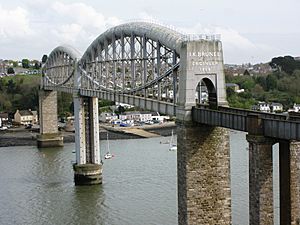
Isambard Kingdom Brunel designed and built the amazing Royal Albert Bridge, finished in 1859. This bridge really helped connect the Three Towns to the rest of the country.
However, high rents and crowded conditions in old buildings led to poor living standards. A government report in 1852 said conditions were some of the worst in Europe! This led to many old parts of the city being cleared and new public housing being built.
The Guildhall, Law Courts, and Municipal Offices were built in the 1870s. These grand buildings showed the city's growing pride. Most of this complex was later destroyed, but about a third, including the tower, was rebuilt in the 1950s. Plymouth finally became an official city in 1928.
Until World War II, the port at Millbay Docks was used for large Transatlantic ships. Many of the surviving crew from the RMS Titanic disaster came ashore at Millbay docks in 1912 when they returned to England.
During the First World War, Devonport Dockyard employed about 20,000 workers. After the war, jobs declined due to less naval spending and the Great Depression. However, Plymouth still suffered less than cities that relied only on commercial shipbuilding.
Plymouth Pier, built in 1884, and the unique Art Deco Tinside Pool from 1935 were built as fun places by the sea. This showed that tourism was becoming more important to the city's economy.
World War II and Beyond
Because it was so close to France and had a huge naval base, Plymouth was heavily bombed by the Luftwaffe during the Second World War. This is known as the Plymouth Blitz. The dockyards were the main targets, but also shopping centres, civic buildings, and over 3,700 homes were destroyed. More than 1,000 civilians lost their lives. Charles Church was left in ruins as a memorial to those who died. On the Plymouth Hoe, there's a memorial to the many Royal Navy members from Plymouth who died in both World Wars.
In June 1944, Plymouth was a key starting point for the Normandy Landings. General Omar Bradley and the 1st US Army sailed from here for the landings at Omaha Beach and Utah Beach.
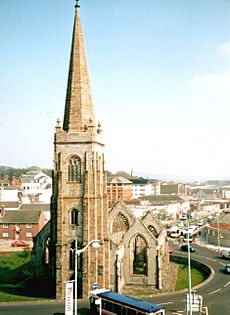
After the war, in 1943, Sir Patrick Abercrombie created a "Plan for Plymouth" to rebuild the devastated city. This plan aimed to replace old buildings with wide, modern roads. The main focus was on housing. Many temporary homes were built by 1946, followed by thousands of permanent council houses each year from 1951 to 1957. By 1964, over 20,000 new homes had been built.
The Admiralty needed more space after the war. Devonport Dockyard stayed busy for many years, fixing large ships like the Ark Royal. When this work ended in the late 1970s, the nuclear submarine base was ready. In the 1950s, a new Royal Navy Engineering College was built at Manadon, and HMS Raleigh, the Navy's basic training facility, opened near Torpoint.
In 1962, the Plymouth Civic Centre was built. It's a modern building that holds the city offices. In 2007, it was given special protection to prevent it from being torn down.
On May 28, 1967, Sir Francis Chichester returned to Plymouth. He had just completed the first solo trip around the world by sailing ship! An estimated one million people gathered on the Hoe and along the coast to greet him.
In 1988, to mark 400 years since the defeat of the Spanish Armada, most of the city centre became a pedestrian-only area. It was landscaped, and a new shopping centre called the Armada Centre was built. This showed the city's shift towards tourism as jobs at the Dockyards began to decrease.
Images for kids
-
The Citadel in 1737


